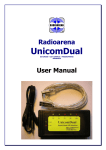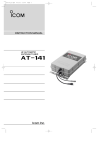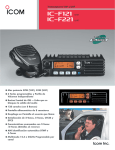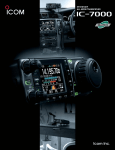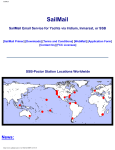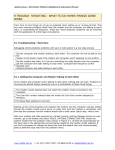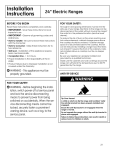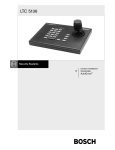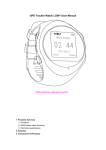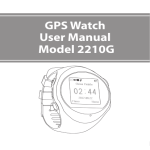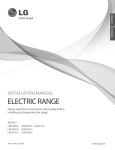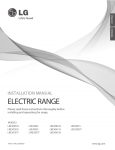Download ICOM - AT-140 User manual
Transcript
INSTRUCTION MANUAL HF AUTOMATIC ANTENNA TUNER AT-140 Downloaded by Amateur Radio Directory FOREWORD PRECAUTIONS Thank you for purchasing the AT-140 HF AUTOMATIC ANTENNA TUNER. R DANGER HIGH VOLTAGE! NEVER touch The AT-140 is designed, primarily for use with Icom HF transceivers. the antenna terminal, ground terminal, antenna or counterpoise while transmitting. Place the AT-140, antenna and counterpoise in positions where no one can touch them. Refer to your HF transceiver instruction manual for operation. If you have any questions, contact your dealer. NEVER use without a ground connection. NEVER transmit during internal adjustment. This may cause an electric shock. IMPORTANT USE the ground terminal for ground connection. The mounting plate is not connected internally. READ ALL INSTRUCTIONS carefully and completely before using the AT-140. SAVE THIS INSTRUCTION MANUAL. This instruction manual contains important safety and installation instructions. Ground terminal EXPLICIT DEFINITIONS Mounting plate Word Definition Personal injury, fire hazard or electric R WARNING shock may occur. CAUTION NOTE DO NOT operate your HF marine transceiver without Equipment damage may occur. running the boat’s engine. If disregarded, inconvenience only. No personal injury, fire hazard or electric shock. AVOID using the AT-140 in areas where the temperature is below –30°C (–22°F) or above +60°C (+140°F). SUPPLIED ACCESSORIES The following accessories are supplied with the AT-140. q u w i e r t o y !2 !0 Qty. q U-bolts ………………………………………………2 w U-bolt plates …………………………………………2 e Flat washers (M6 large) ……………………………8 r Flat washers (M6 small) ……………………………4 t Spring washers (M6) ………………………………8 y Nuts (M6) ……………………………………………8 u Hex head bolts (M6×50) ……………………………4 i Self-tapping screws (A0 6×30) ……………………4 o Weatherproof cap……………………………………1 !0 6-pin connector………………………………………1 !1 Connector pins ………………………………………4 !2 Ground cable (OPC-412) …………………………1 !1 Icom, Icom Inc. and the are registered trademarks of Icom Incorporated (Japan) in the United States, the United Kingdom, Germany, France, Spain, Russia and/or other countries. i MISCELLANEOUS ITEMS TABLE OF CONTENTS The following parts are additionally required for installation, but are not supplied with the AT-140. Purchase these parts locally. FOREWORD …………………………………………… i q AWG 14×4-conductor shielded cable *Icom offers an optional OPC-1147 CONTROL CABLE. Length: 10 m; 32.8 feet w 50 Ω coaxial cable e PL-259 connectors IMPORTANT …………………………………………… i EXPLICIT DEFINITIONS ……………………………… i PRECAUTIONS ……………………………………… i SUPPLIED ACCESSORIES ………………………… i MISCELLANEOUS ITEMS ………………………… ii FEATURES …………………………………………… ii FEATURES Matches all bands The AT-140 matches any frequency on every HF marine band. For example, the tuner matches a 7 m; 23 ft long-wire antenna across 1.6–30 MHz. Full automatic tuning Just push the [TUNE] switch on the transceiver, and the AT-140 adjusts immediately to the minimum SWR of any frequency on any HF marine band. HF operation on any size ship The AT-140 allows you HF operation where antenna element length is restricted due to space. Weather resistant The AT-140 is housed in a durable, completely weather resistant ASA case with a rubber gasket. The antenna tuner can be conveniently installed both on the deck or in the cabin near the antenna element. Simple installation Installation is simple. Just connect the control and antenna cables. You never need to open the cover. TABLE OF CONTENTS ……………………………… ii 1 ANTENNA SYSTEM …………………………… 1–2 ■ Antenna for ship ………………………………… 1 ■ Antenna for land operation ……………………… 1 ■ Coaxial cable …………………………………… 2 ■ Ground and counterpoise ……………………… 2 2 INSTALLATIONS ………………………………… 3–5 ■ lnstallation outline………………………………… 3 ■ Control cable……………………………………… 3 ■ PL-259 connector………………………………… 4 ■ Mounting ………………………………………… 4 ■ Cable connections ……………………………… 5 3 CONTROL CABLE SIGNALS ………………… 6–7 ■ Terminal information …………………………… 6 ■ Transceiver setting ……………………………… 7 4 UNIT DESCRIPTION AND SPECIFICATIONS ………………………………………………………… 8 ■ Unit description…………………………………… 8 ■ Specifications …………………………………… 8 45 memories for shorter tuning time To decrease the tune-up time, the AT-140 automatically stores the matching conditions for up to 45 frequencies. Re-tuning for a memorized frequency takes approx. 1 sec. Super capacitor for memory backup Even if the AT-140 is not used for approx. 1 week, the built-in super capacitor backs up contents of the 45 memories. Low power tune up The AT-140 emits low output power during tuning. This feature reduces the possibility of causing interference to other stations. Tuner through function The tuner through function is built into the AT-140. This function helps improve receiver gain, depending on the antenna element length used, and operating frequency. ii 1 ANTENNA SYSTEM ■ Antenna for ship Required antenna element length Required antenna element length to achieve full performance varies according to the lowest frequency: The lowest frequency Required antenna element length 1.6 MHz band 7 m; 23.0 feet or longer 4 MHz band 3 m; 9.8 feet or longer Insulator Backstay operates as a long-wire antenna. The longer the antenna element, the better the antenna efficiency. Undesirable antenna element lengths AVOID multiples of 1⁄2λ (half wavelength) for an- Insulator tenna element lengths, since tuning becomes difficult. L : Antenna element length to be avoided [m] f : Operating frequency [MHz] n : Natural number (n = 1, 2, 3, ...) L= 300 1 × × n 2 f Whip antenna [Example] At an operating frequency of 16 MHz, avoid the following antenna element lengths: L= 300 1 × × n 2 16 1m 39 inches 9.4, 18.8, ... For example, if 15 m is selected for an antenna element length, you have no problem in the 1.6–25 MHz marine bands range. NOTE: Keep antennas as far away from other objects as possible, especially metal objects. ■ Antenna for land operation In some countries, HF transceivers can be used for land mobile operation. Ask your Icom Dealer for details, since the radio law varies according to each country. For land mobile operation on 4 MHz and above, an optional AH-2b ANTENNA ELEMENT is available. The AH-2b includes a sturdy tow hook mount system for holding a 2.5 m; 8.2 feet stainless steel antenna element plus all the necessary hardware. AH-2b 1 Refer to the AH-2b instruction manual for the AH-2b and AT-140 installation to your vehicle. Ask your Icom Dealer for details. Connect a suitable antenna element for a base station. To achieve full performance, refer to “Required antenna element length” above. ANTENNA SYSTEM 1 ■ Coaxial cable Insulate the lead-in cable of the AT-140 antenna terminal and antenna element from other metal objects. To prevent erroneous indications, keep cables as far away as possible from the flux gate compass. To prevent interference, keep cables as far as possible from an antenna, electric pump and other electronic equipment. Use suitable noise filters for alternators, fluorescent lights, etc. Ask your Dealer for details. ■ Ground and counterpoise Why a ship’s ground is required The AT-140’s ground terminal MUST be connected to your ship’s ground. Grounding prevents electric shocks, interference to other equipment and other problems. Grounding also ensures effective signal transmission. Counterpoise If your ship is made of FRP, etc. and a good ship’s ground is not available, connect a counterpoise. 1⁄4λ radial for each band Ground terminal DANGER! NEVER connect the ground terminal to the following points. These connections may cause an explosion or electric shocks: – Gas or electrical pipe – Fuel tank or oil-catch pan IMPORTANT! The mounting plate is NOT connected to the AT-140’s internal ground. Ideal ground points One of following points is ideal: – External ground plate – External copper screen – External copper foil AT-140 1⁄4λ (quarter wavelength) radial for each band is suitable for a counterpoise. Install the counterpoise directly below the AT-140’s ground terminal. Insulate the ends of each radial from other metal objects. Layout the radial horizontally and as straight as possible. L : Counterpoise length for the operating frequency [m] f : Operating frequency [MHz] Good ground points If electrically connected to sea water, one of the following points is usable: – Stainless steel stanchion – Through mast – Through hull – Metal water tank Undesirable ground points AVOID the following points, if possible. These connections may cause noise or electrolysis: – Engine block – Ship’s DC battery ground Electrolysis All ground cables from the AT-140, HF transceiver, etc. on your ship should be connected to only 1 ship’s ground. AVOID connection to 2 or more points. Voltage difference between 2 or more ship’s grounds may cause electrolysis. AVOID connection between dissimilar metals where an electric current is present. These connections may cause electrolysis. L= 300 1 × f 4 [Example] At an operating frequency of 16 MHz, use a counterpoise with the following length: L= 1m 300 1 × 16 4 4.7 [m] 39 inches Ground cable For best results, use the heaviest gauge wire or metal strap available. Make the distance between the AT140’s ground terminal and ship’s ground as short as possible. Supplied ground cable can be used for ground connection to a through mast. Confirm that the through mast is electrically connected to sea water. R WARNING!— When grounding to metal hull Use a Zinc anode to protect the hull from electrolysis. Ask your technical dealer, installer or refer to a technical book, etc., for RF ground details. 2 2 INSTALLATIONS ■ Installation outline q Connect a control cable and 4-conductor shielded cable. r Connect the control cable and the coaxial between the transceiver and the AT-140. • Refer to “Control cable” below. • Refer to p. 5 “Cable connections.” w Connect and solder the PL-259 connector to the coaxial cable. t Connect an antenna, ship’s ground or counterpoise. • Refer to p. 1 “Antenna for ship” and p. 2 “Ground and counterpoise.” • Refer to p. 4 “PL-259 connector.” e Mount the AT-140 in the desired location. • Refer to p. 4 “Mounting.” ■ Control cable Between the AT-140 and HF marine transceiver, connect 4 control signal lines as shown below. To prevent RF feedback, use a 4-conductor shielded cable. Connect the shield line to the [GND] terminal on the transceiver. Icom offers 10 m (32.8 ft) long optional control cables as at right. OPC-566 OPC-1147 : for IC-M710/RT, M700PRO : for IC-M802 Refer to p. 6 “Terminal information” for details. D When connecting to Icom IC-M802 To transceiver [E] [13.6] [STAR] [KEY] : : : : Black Red White Green To AT-140 Use the optional OPC-1147, or assemble the desired length 4-conductor shielded cable and the connector kits supplied with the transceiver and the tuner. [GND] [E] [13.6] [STAR] [KEY] : : : : Black Red White Green [E] [13.6] [STAR] [KEY] : : : : Black Red White Green [E] [13.6] [STAR] [KEY] : : : : Black Red White Green [GND] D When connecting to Icom IC-M710/RT, IC-M700PRO [STAR] : White [KEY] : Green [13.6] [E] To transceiver : Red : Black Use the optional OPC-566/1147 (either the connector to the AT-140 or the transceiver requires assembly), or assemble the desired length 4-conductor shielded cable and the connector kits supplied with the transceiver and the tuner. [GND] To AT-140 [GND] D When connecting to Icom IC-M700/TY, IC-78 To transceiver [E] [13.6] [STAR] [KEY] : : : : Black Red White Green Use the optional OPC-1147 (this connector only requires assembly), or assemble the desired length 4conductor shielded cable and the connector kits supplied with the transceiver and the tuner. [GND] 3 [GND] To AT-140 INSTALLATIONS 2 ■ PL-259 connector q Slide the coupling ring over the coaxial cable. Strip the cable jacket and pull back to reveal 10 mm of braid. e Slide the connector body over the cable and solder as shown below. Solder Solder • Soft solder the exposed braid and then pull out the jacket. Coupling 30 mm r Screw the coupling ring onto the connector body. 10 mm (soft solder) w Strip the cable as shown below. Soft solder the center conductor the entire length of the exposed braid. 10 mm 10 mm 3⁄8 1–2 mm soft solder inches ■ Mounting Attach the AT-140 either horizontally or vertically with one of the water drains facing downwards. After mounting, remove the screw in the water drain. Mounting on a flat surface Using nuts and bolts Using self-tapping screws Mounting on a Mast/Metal pole Mast/ Using Metal pole U-bolt U-bolts U-bolt plate Flat washer(L) Spring washer Flat washer(S) Nut Nut Flat washer(S) Spring washer Flat washer(L) WARNING: Mount the AT-140 securely with the supplied nuts and bolts. Otherwise, vibrations and shocks due to waves, etc. could loosen the antenna tuner making if fall, causing personal injury. Flat washer(L) Hex head bolt Weatherproof cap Drill a hole here Diameter:7–8 mm; 9⁄32–5⁄16 inches Downloaded by Amateur Radio Directory 4 2 INSTALLATIONS ■ Cable connections q Connect the coaxial cable and the control cable to the AT-140 as illustrated below. w Cover both the antenna and the control cable connectors with rubber vulcanizing tape and fix it with a vinyl tape to prevent water seeping into the connector. r Connect the coaxial cable and the control cable to the transceiver as illustrated below. t Ground the transceiver, AT-140 and shield cable of the control cable via the ground terminal. • See pgs. 2 and 7–10 for grounding details. IMPORTANT!— AT-140 NEVER ground the AT140 via the mounting plate. It is not connected to ground internally. Rubber vulcanizing tape Ground terminal e Fix both of the coaxial and control cables to protect the inside connections. Mounting plate DO NOT pull the antenna and control cable receptacles. This may cause disconnection (in the AT-140), internal connector damaged or bad connection. Icom HF transceiver AT-140 Ground Ground (10 -1147 .8 ft) m; 32 OPC Downloaded by Amateur Radio Directory 5 CONTROL CABLE SIGNALS 3 ■ Terminal information Consider the following points when using a non-Icom transceiver. Terminal Description [KEY] Key voltage. Grounded during tuning. Max. current drain 100 mA. [13.6] 13.6 V DC + input terminal. Max. current drain 2 A [STAR] [E] Start voltage [STAR] When a start voltage (less than 1 V) is received, the AT-140 begins automatic tuning. More than 350 msec.* Start voltage 8 [V] 6 Approx. 7.5 V 4 Receives start voltage. Max. current drain 1 mA Less than 1 V to start tuning 2 0 Ground terminal for above signals. Time *For tuner through operation; Less than 250 msec. Key voltage [KEY] During automatic tuning, the AT-140 grounds the key voltage line, and the HF transceiver reduces output power. During automatic tuning Key voltage 8 [V] 6 [KEY] [STAR] [13.6] [E] Approx. 7.5 V 4 2 0 Grounded Time If the key voltage is more than 8 V, switch the mode switch (S1) to OFF mode (lower position). [E] [13.6] [STAR] [KEY] S1 NORMAL mode OFF mode Mode switch (S1) Downloaded by Amateur Radio Directory 6 3 CONTROL CABLE SIGNALS ■ Transceiver setting IC-M700 with serial number 2500 and below In the IC-M700, change the [TUNE] switch setting from the “1” position to the “2” position. Confirm that the [KEY] switch is in the “2” position. Refer to the ICM700 instruction manual p. 9 for details. [KEY] [TUNE] Confirm “2” position. Select “2” position. Other IC-M700 and IC-M700TY Nothing necessary to set. However, the tuner through function is not available when using the AT-140 with IC-M700/TY. IC-78 In the IC-78, select the antenna tuner type as “4* (AH4)” in initial set mode. See IC-78 instruction manual p. 32 for details. IC-M710/RT, IC-M700PRO In the IC-M710/RT and IC-M700PRO, select the antenna tuner type as “AH-3*” in initial set mode. See IC-M710/RT instruction manual p. 13 or IC-M700PRO instruction manual p. 11 for details. IC-M802 In the IC-M802, select the antenna tuner type as “AT140” in initial set mode. See IC-M802 instruction manual p. 49 for details. Non-Icom HF transceiver Select correct settings for the start voltage and key voltage. Refer to your HF transceiver instruction manual for details. NOTE: When a non-Icom automatic tuner was previously used, confirm the tuner settings. Refer to the instruction manual for details. *With “AT-130” setting, use of the AT-140 is possible, however, the tuner through function cannot be operated. 7 UNIT DESCRIPTION AND SPECIFICATIONS 4 ■ Unit description 340 mm; 13.4 in 230 mm; 9.1 in 80 mm; 3.1 in Ground terminal Mounting plate Water drain screw Antenna cable receptacle Control cable receptacle Antenna terminal Mounting plate 91.5 mm; 3.6 in Downloaded by Amateur Radio Directory ■ Specifications • Frequency coverage • Power supply requirement • Current drain • Operating temperature range • Weight • Antenna connector • Max. Input power • Automatic tuning time • Automatic tuning accuracy : 1.6–30 MHz (with 7 m; 23.0 feet or longer antenna element) : 13.6 V DC (supplied from HF transceiver) : Max. 2 A : –30°C to +60°C (–22°F to +140°F) : 2.5 kg; 5.5 lb : SO-239 (50 Ω) : 150 W (PEP) 100 W (continuous) : Approx. 2–3 sec. (general condition) Max. 15 sec. Approx. 1 sec. (re-tuning for a memorized frequency) : SWR 2.0:1 (after tuning, except for multiples of 1⁄2 λ) All stated specifications are subject to change without notice or obligation. 8 Icom America Inc. Icom (Europe) GmbH <Corporate Headquarters> 2380 116th Avenue N.E., Bellevue, WA 98004, U.S.A. Phone: (425) 454-8155 Fax: (425) 454-7619 URL: http//www.icomamerica.com Communication Equipment Himmelgeister Str. 100, D-40255 Düsseldorf, Germany Phone: 0211 346047 Fax: 0211 333639 URL: http//www.icomeurope.com <Customer service> Phone: (425) 454-7619 Icom Canada Icom Spain S.L. Glenwood Centre #150-6165 Highway 17, Delta, B.C., V4K 5B8, Canada Phone: (604) 952-4266 Fax: (604) 952-0090 URL: http//www.icomcanada.com Ctra. de Gracia a Manresa Km. 14,750 08190 Sant Cugat del Valles Barcelona, SPAIN Phone: (93) 590 26 70 Fax: (93) 589 04 46 URL: http//www.icomspain.com Icom (Australia) Pty. Ltd. Icom (UK) Ltd. A.C.N. 88 006 092 575 290–294 Albert Street, Brunswick, Victoria, 3056, Australia Phone: (03) 9387 0666 Fax: (03) 9387 0022 URL: http//www.icom.net.au Unit 9, Sea St., Herne Bay, Kent, CT6 8LD, U.K. Phone: 01227 741741 Fax: 01227 741742 URL: http//www.icomuk.co.uk Icom New Zealand Icom France S.a 146A Harris Road, East Tamaki, Auckland, New Zealand Phone: 09 274 4062 Fax: 09 274 4708 URL: http//www.icomam.co.nz Zac de la Plaine, Rue Brindejonc des Moulinais BP 5804, 31505 Toulouse Cedex, France Phone: 561 36 03 03 Fax: 561 36 03 00 URL: http//www.icomeurope.com Asia Icom Inc. Beijing Icom Ltd. 6F No. 68, Sec. 1 Cheng-Teh Road, Taipei, Taiwan R.O.C. Phone: (02) 2559 1899 Fax: (02) 2559 1874 URL: http//www.asia-icom.com 1035, Wanshang Plaza, Shijingshan Road, Beijing Chaina Phone: (010) 68666337 Fax: (010) 68663553 Downloaded by Amateur Radio Directory A-6175H-1EX Printed in Japan © 2002 Icom Inc. 1-1-32 Kamiminami, Hirano-ku, Osaka 547-0003 Japan












